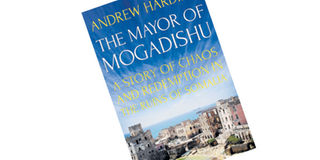New book unearths intriguing prose from the ruins of Mogadishu

The cover for Andrew Harding's The Mayor of Mogadishu. PHOTO | MARTIN MUKANGU |
What you need to know:
Book title: The Mayor of Mogadishu: A Story of Chaos and Redemption in the Ruins of Somalia
Author: Andrew Harding
Year of publication: 2016
Published by: C. Hurst & Co (Publishers) Ltd
Genre: Non-fiction
The Mayor of Mogadishu leaves no room for prejudices. Not that it should, but Somalia rarely invokes anything but images of violence and feelings of doom.
According to the author, Somalia’s capital Mogadishu has a name that seems forbidding.

Andrew Harding during the Nairobi launch of his book "The Mayor of Mogadishu" at PAWA 254's rooftop on October 13, 2016. PHOTO| THOMAS RAJULA
“Like Stalingrad, Kabul, Grozny, and these days, Syria’s Homs, Mogadishu conjures up lurid images of destruction.”
The author’s words in the epilogue illuminate the collective prejudice and patronising attitude that have often dominated rhetoric about Africa. He says: “…I’ve always bristled against grand predictions — a favourite hobby of foreigners throughout Africa, anxious to pin epitaphs to Zimbabwe, South Africa, Nigeria, Mali or Kenya. The continent is either doomed to fail or rising like a phoenix.”
Celebrated African writer Chimamanda Ngozi Adichie sums this up as the ‘danger of a single story’ in her widely viewed TED Talk by the same title.
Andrew Harding is not vulnerable to this danger. His confrontations of the truths (and half-truths) that Mohamud ‘Tarzan’ Nur, his main subject, offers in their many interactions are as bare-knuckled as they can be as he traces the life of the would-be mayor of Mogadishu from his nomadic roots, his time at the orphanage, (where he was taken by his aunt) his courtship with his wife Shamis, his time in London, and finally his descent back into Somalia 20 years later as the mayor, at a time when only five of Somalia’s cities were under the control of the government, with the rest under Al-Shabaab.
The book begins on Friday, February 21, 2014 and “in a country where the percussion of violence — gunshots, rockets, mortars, grenades, bombs — has, over the decades, become embedded in people’s minds as the background music of any ordinary day…” This excerpt describes an Al-Shabaab attack on Villa Somalia, where President Hassan Sheikh and most of his cabinet members were based. A car bomb has just been detonated outside the hotel. Tarzan is in Villa Somalia’s mosque when the attack happens. That is how we first meet him: in the face of imminent death, and staring down at it with the courage that even his critics, interviewed by the author, don’t contest.
CHEATED DEATH
This is, however, not the first time that Tarzan manages to cheat death in the book, as he ‘whirlwinds’ his way through the city of Mogadishu, declaring that any Al-Shabaab militant should be eliminated on the spot, that mobs should stone them to death.
“I will not die twice, I never expected that I would come out alive when I took the job,” Tarzan often offered as a way of explanation, both to the author and in previous interviews with the BBC.
Coming back to Mogadishu with a nascent ambition for a political career after two decades abroad, his appetite for politics grows so much that he has declared his candidature for Somalia presidency. The author interestingly points out that Tarzan’s former title, Mayor of Mogadishu, was also once used by opponents of then Somalia president Siad Barre, to mock him.
Tarzan’s story, the author says, is a “glint worth following in a dark maze”. And a dark maze it is, but perhaps most darkened by dictator Siad Barre, whom the author compares to Syria’s president Assad, and Al-Shabaab insurgents, whom Tarzan tries to contain with relative success, and who welcomed him on his first night back home by firing rockets at his hotel. The Mayor of
Mogadishu is certainly a literary gem, bursting at the seams with breathtaking descriptions, song, wit, humour, onomatopoeia and heightened language.
Harding’s use of imagery is particularly spectacular, as in one instance, in chapter six, when he describes the exodus of Somalis as the spasms of migration that shuddered through an imploding country.
SEAMLESS PROSE
The book is, in a way, autobiographical, as it offers glimpses of the author’s life in Africa but this is in the sub-text.
Somalia’s transitions are articulated in fluid, seamless prose. Not once after reading Michela Wrong’s It’s Our Turn to Eat have I encountered such a creatively written non-fiction work.
The author, maybe as a result of the leave-no-stone-unturned research, pulls the reader in different emotional directions.
Awe, sympathy, apathy, doubt are just some of the ingredients that the cocktail of emotions the book forces you to drink from are made of, but never indifference. One can’t help but wonder if the controversial and very unapologetic character of Tarzan forces him to do so.
Somali Novelist Nuruddin Farah, author of Hiding in Plain Sight among other literary works, and Kenyan-based whistle-blower Abdirazak Fartaag, are among some of the familiar names that the author interviews for the book and that readers might recognise.
Harding delicately, tenderly and honourably tackles the topic of Somalia, the fragile nation which is currently selecting a new parliament, upper house and president, and with the main interview subject, Tarzan, having declared his candidature for presidency.
The author’s sincere voice rings clearly throughout the book, offering the reader not just Tarzan’s story, but of his family’s, close associates and opponents’ views as well.
Harding has worked as a foreign correspondent for the past 25 years, and took a break to write this book.
One must assume that the author had the choice to be prescriptive in his writing, offering solutions to Somalia’s problems, but instead he simply chose to be descriptive, offering a refreshing break from other books with ominous titles and “expert” voices.
The book is available at local bookstores.





